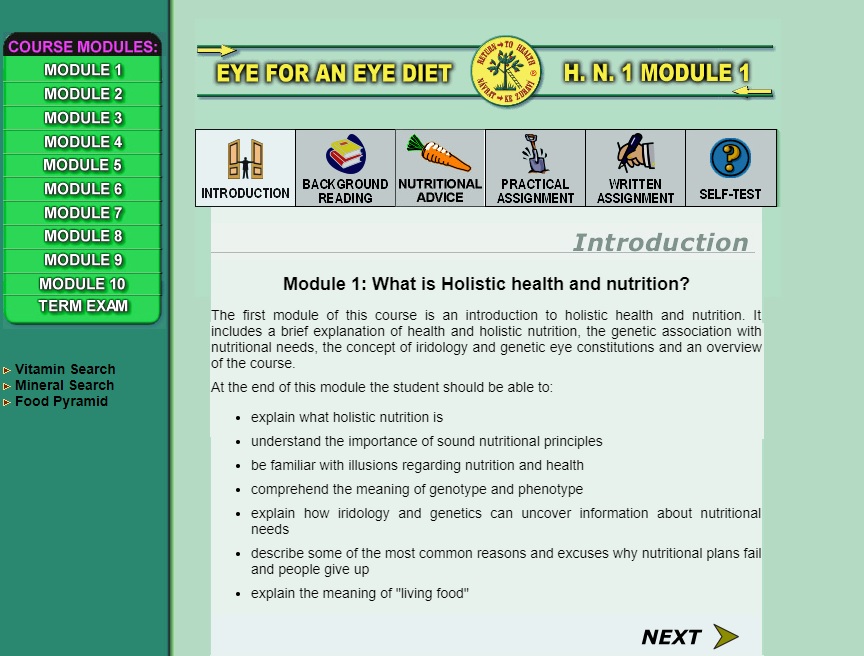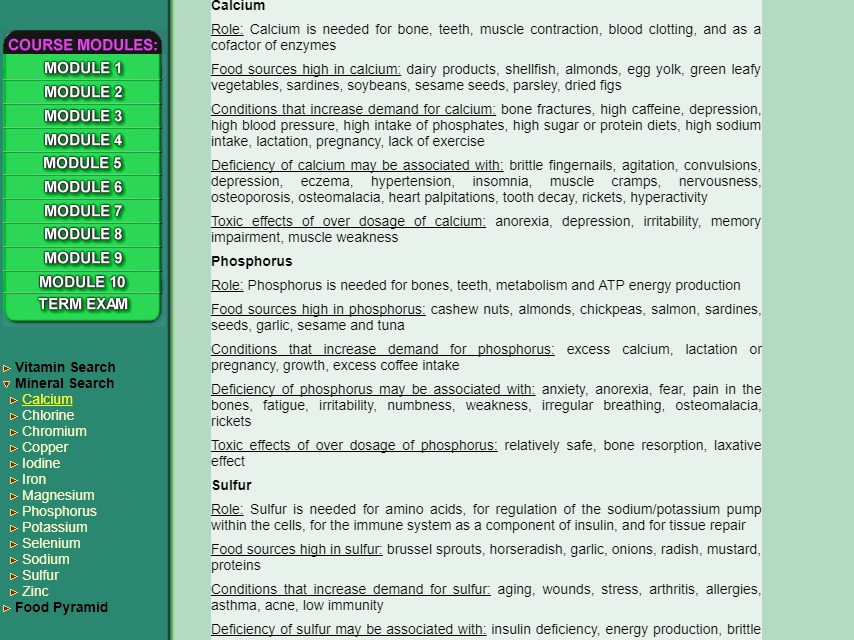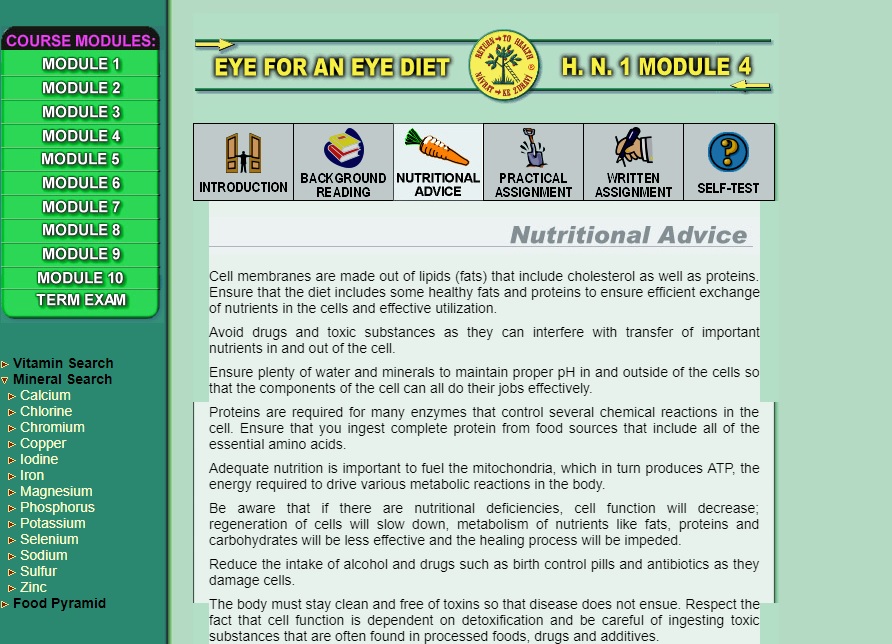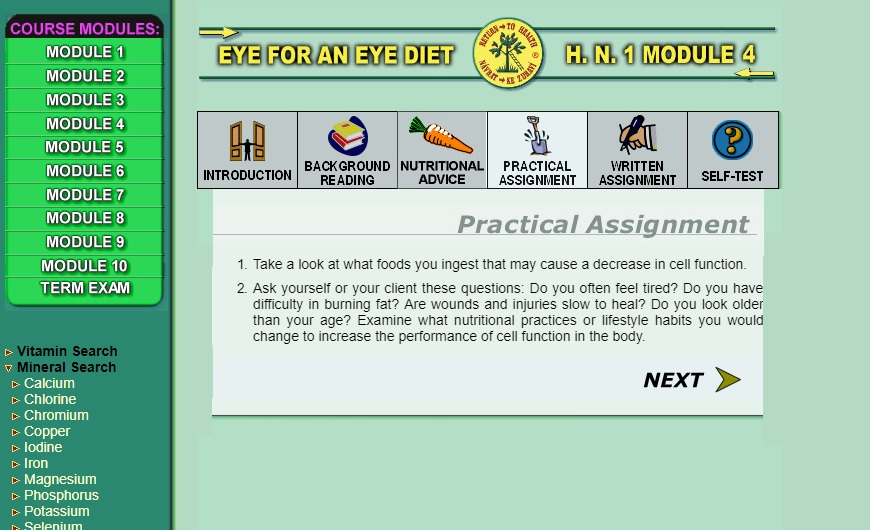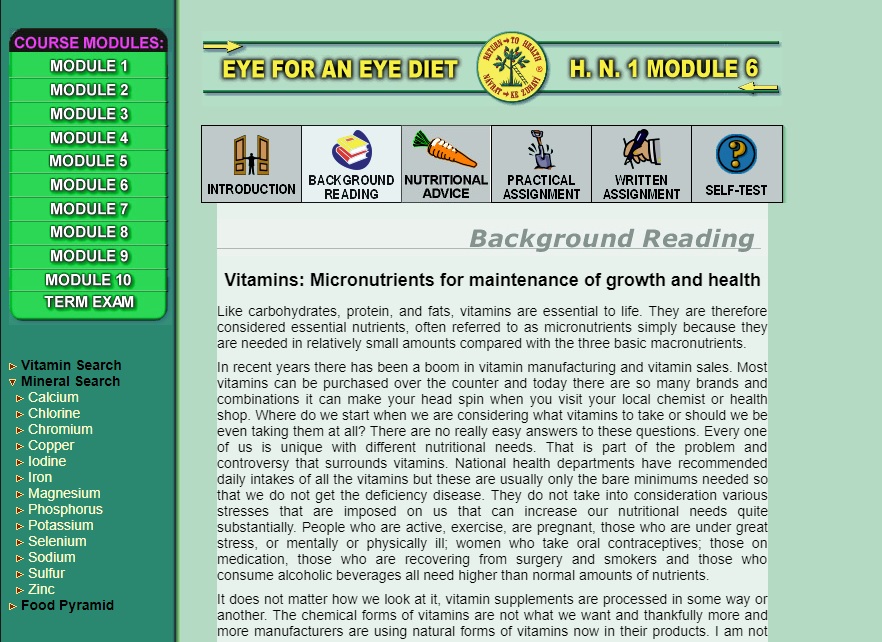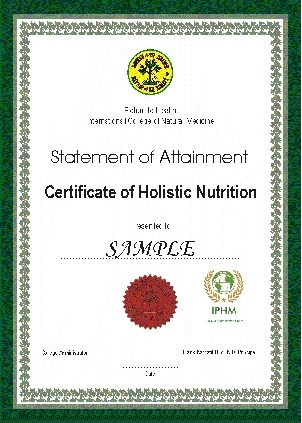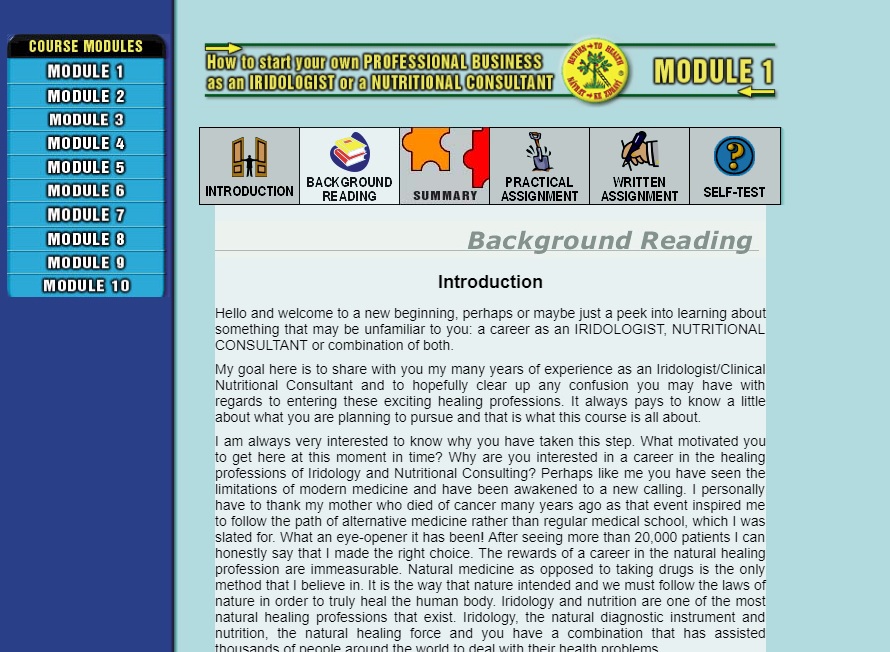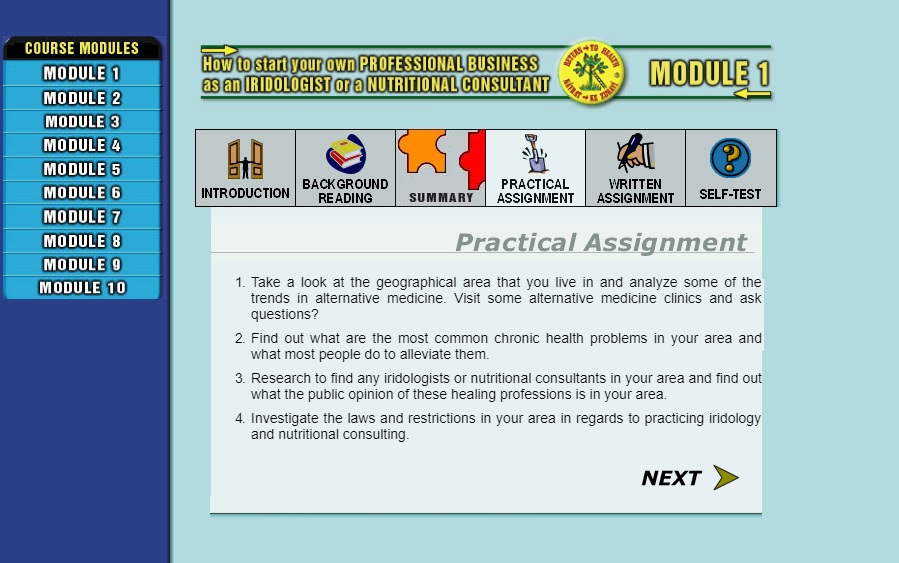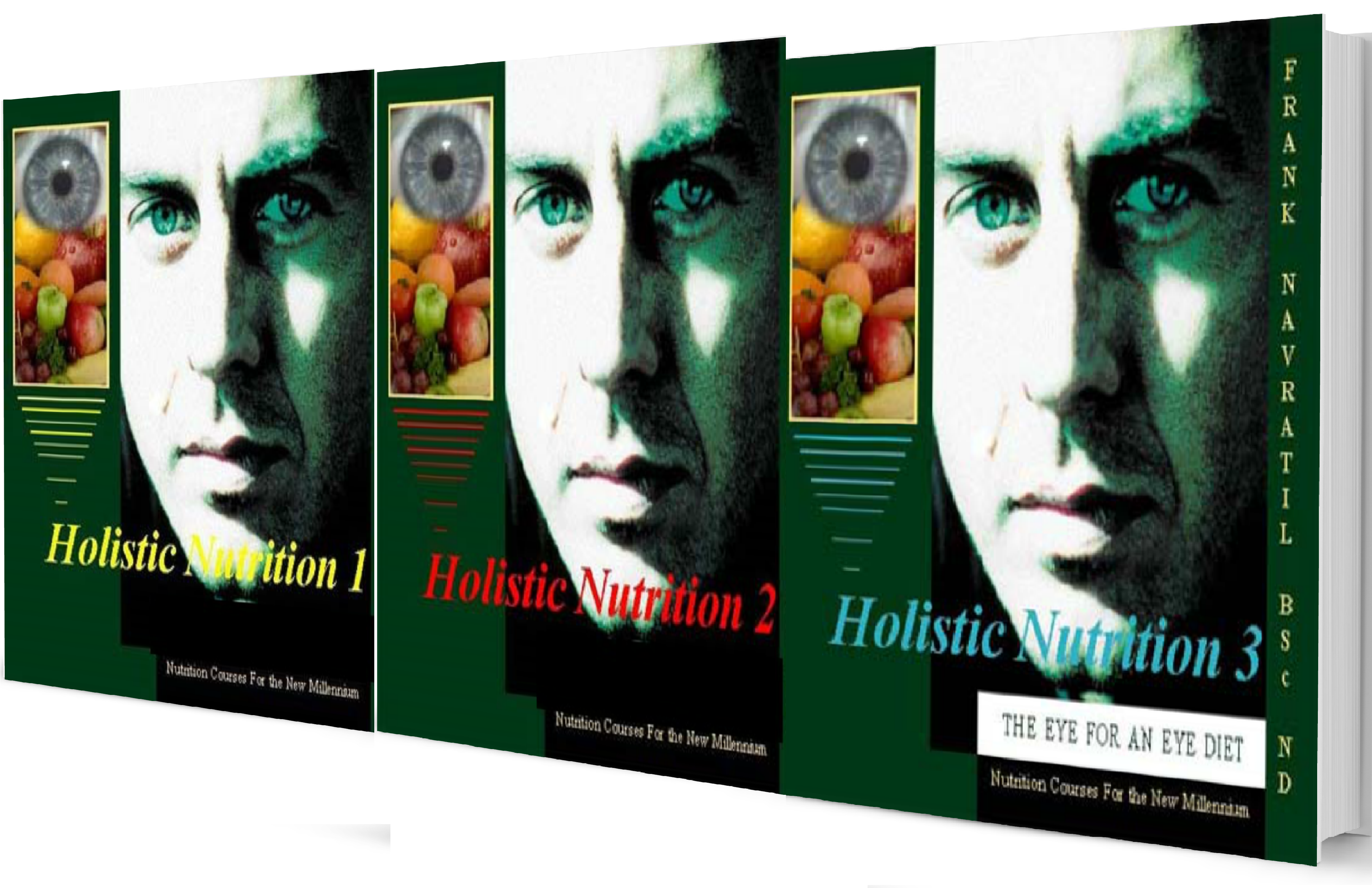
$695.00Add to cart
HOLISTIC NUTRITION COMPLETE CERTIFICATION COURSE (FOR PC/WINDOWS)
The Holistic Nutrition course is a series of three interactive downloadable courses by Frank Navratil BSc. N.D., a world-renowned author, iridologist, naturopath, and clinical nutritionist.
Holistic Nutrition is a summary of all the factors that need to be considered when we deal with nutrients that the body requires. Holistic nutrition takes into account our genetic requirements for nutrition as well as nutrients that are required for growth, regeneration from disease, stresses that we impose on our bodies and changes as we age. Holistic nutrition takes into consideration individual needs, as every one of us is different.
The Holistic Nutrition course guides the beginner to advanced nutrition student or natural therapy practitioner through step-by-step theory, practical and written assignments, charts and diagrams, automatically correcting self-tests and term exams. Whether you are a healthcare practitioner or just a layperson, whether you just want to lose weight, cure your disease through nutrition, or just want to learn more about how to stay healthy and prevent disease from occuring, these courses allow you to learn about nutrition in an easy, unique and interactive way.
Each module of each course is designed to take approximately 2 hours to complete on average although you can work entirely at your own pace and there are 10 modules for each level of each course and 3 levels all together.
Receive a “Certificate of Holistic Nutrition” at the end of all 3 levels after successful completion of all exams with a grade of 80 percent or more. The Certificate of Holistic Nutrition course is internationally accredited with the IPHM (International Practitioners of Holistic Medicine). You can become a member of th IPHM once you complete our course. More information can be found on www.iphm.co.uk.
If you do not receive a grade of 80 percent or more on your exam result you can redo the examination as many times as you like until you achieve the required grade. There are no additional costs for examinations. End of term exams must be emailed directly to us. You must successfully complete all 3 levels (Holistic Nutrition 1, 2 and 3) to receive a “Certificate of Holistic Nutrition” issued by the Return to Health International College of Natural Medicine. Go back to the main menu for information about the Return to Health International College of Natural Medicine.
On-line support for any problems or questions you may have during the course. Frank Navratil BSc. N.D. personally is available on-line to assist you during your nutrition course.
Module 1 – What is Holistic health and nutrition?
The first module of this course is an introduction to holistic health and nutrition. It includes a brief explanation of health and holistic nutrition, the genetic association with nutritional needs, the concept of iridology and genetic eye constitutions and an overview of the course.
At the end of this module the student should be able to:
- explain what holistic nutrition is
- understand the importance of sound nutritional principles
- be familiar with illusions regarding nutrition and health
- comprehend the meaning of genotype and phenotype
- explain how iridology and genetics can uncover information about nutritional needs
- describe some of the most common reasons and excuses why nutritional plans fail and people give up
- explain the meaning of “living food”
Module 2 – Essential Principles of Nutrition Part 1
The second module of this course is Part 1 of the essential principles of nutrition. It includes lessons from the old and wise, the importance of catering to individual nutritional needs, the seven essential processes of life, the components of holistic health and the iridology-nutrition connection.
At the end of this module the student should be able to:
- Understand the importance of learning from the old and other cultures
- Appreciate individual differences and the need for custom-tailored nutritional programs
- List the seven essential processes of life and understand their importance in human nutrition
- Describe holistic components that influence our health and nutritional needs
- Explain the iridology-nutrition connection
Module 3 – Essential Principles of Nutrition Part 2
Module 3 continues with Part 2 of the Essential Principles of Nutrition. It includes making health food choices, avoiding crash diet programs, living according to nature’s laws, changing with the demands of the body and removing obstacles that stand in the way of successful health programs.
At the end of this module the student should be able to:
- Understand the healing capability of foods
- Appreciate the importance of lifestyle changes as opposed to crash diets
- See the negative effects that abusing nature’s laws has on our health
- List the age-related and non age-related time of stress that affect the nutritional demands of the body
- Identify the obstacles that often prevent achievement of health and nutritional goals
Module 4 – The Cell
Module 4 of this course outlines the importance of the cell in human nutrition. It includes facts about different types of cells, their functions and their components, as well as their vital role in all the essential processes of life.
At the end of this module the student should be able to:
- Define what a cell is
- Describe the two fundamental types of cells
- List some of the roles of cells within the human body
- Explain the relationship of cells with human nutrition
- Outline the various components within a cell as well as their functions
Module 5 – Macronutrients
Module 5 of this course describes those nutrients that are required by the body in large amounts, the macronutrients. These include carbohydrates, proteins and fats, which are explained and examples and recommendations are provided on how they should be included in the diet.
At the end of this module the student should be able to:
- Describe the role of the macronutrients in human nutrition
- Understand the role of carbohydrates and give examples of healthy food choices
- Understand the role of amino acids and proteins and give examples of healthy food choices
- Understand the role of fats and identify the types of fats that are required in a healthy diet
Module 6 – Vitamins
Module 6 of this course outlines the roles of the fat-soluble and water-soluble vitamins as well as nutrients with vitamin-like activity. It includes food sources that are high in each of the vitamins along with factors that increase their demand, associated conditions of their deficiency and toxic effects of over-dosage.
At the end of this module the student should be able to:
- Understand the role of each of the vitamins needed by the body
- List food sources that are high in each of the vitamins
- State conditions that increase the demand for each of the vitamins
- Recognize health conditions that can arise due to deficiency of certain vitamins
- Be familiar with possible toxic side effects that can result due to over-dosage
- Have an understanding of nutrients with vitamin-like activity
Module 7 – Minerals
Module 7 of this course outlines the roles of the major minerals as well as the trace minerals that are required in the diet It includes food sources that are high in each of the minerals along with factors that increase their demand, associated conditions of their deficiency and toxic effects of over-dosage.
At the end of this module the student should be able to:
- Understand the role of each of the minerals needed by the body
- Differentiate between the major minerals and the trace minerals
- List food sources that are high in each of the minerals
- State conditions that increase the demand for each of the minerals
- Recognize health conditions that can arise due to deficiency of certain minerals
- Be familiar with possible toxic side effects that can result due to over-dosage
Module 8 – Water
Module 8 of this course describes one of the most important nutrients for our existence, water. It includes the major roles of water, how we lose water, the conditions that are associated with low water intake and general guidelines for water in our diet.
At the end of this module the student should be able to:
- Identify the important roles of water
- Understand how we lose water from the body and what substances can increase water loss
- List health conditions associated with low water intake
- Describe general recommendations for water intake
Module 9 – Fiber
Module 9 of this course covers the important role of fiber in the diet. It includes what fiber is and what it does in the body, food sources that are high and low in fiber, beneficial effects of fiber in the bowel and health problems that can occur when fiber is missing in the diet.
At the end of this module the student should be able to:
- Understand what fiber is and what it provides for the body
- List food sources that are high in fiber and low in fiber
- Describe the beneficial effects of fiber for human nutrition
- Explain health problems that are often associated with lack of fiber in the diet
Module10 – Food Group Choices
The last module of this course covers food group choices. It includes an analysis of traditional food pyramids and introduces the Eye for an Eye Diet Food Pyramid with examples, recommended servings and benefits of each of the important food groups.
At the end of this module the student should be able to:
- Become familiarized with traditional food pyramids
- Describe the drawbacks of traditional food pyramids
- Understand the various food groups of the Eye for an Eye Diet Food Pyramid
- List the recommended foods and servings for each of the food groups
- List the nutritional benefits of each of the food groups
Term 1 Examination
This examination must be emailed or sent by post to be corrected. You must achieve a score of 80 percent or more to receive a Certificate of Completion for Holistic Nutrition 1. This certificate will be mailed to your address. You will be notified if you are unsuccessful after which you will need to resubmit your exam. There is no limit to the amount of times that you can apply for the certificate. There are 50 multiple-choice questions in total and they are included at the end of your Holistic Nutrition 1 CD-ROM.
 BONUS
BONUS 
The Holistic Nutrition 1 CD includes a Quicksearch
for Vitamins and Minerals as well as a color Food Pyramid
by only a simple click of your mouse.
We thankyou for your interest in or decision to take your Iridology or Nutrition courses through:
Return to Health International College of Natural Medicine
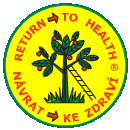
Module 1 – Factors that affect the nutritional value of foods
The first module of Holistic Nutrition 2 outlines the various factors that affect the quality of our food. It introduces the student to some of the ways that nutrients are lost from foods due to factors such as storage and preservation methods, food ripening and food preparation. Issues such as genetically modified foods and agricultural methods are also discussed in this module.
end of this module the student should be able to:
- list the major factors that affect the nutritional value of foods
- appreciate the risks of genetically modified foods
- understand storage and preservation methods that cause nutrient losses from foods
- discuss the advantages and disadvantages of various cooking methods
Module 2 – Food contaminants
The second module of Holistic Nutrition 2 introduces the student to contaminants that are often found in our food supply. Sources of food contaminants as well as guidelines on how to reduce their intake with food are explained. An explanation of controversial contaminants such as fertilizers, pesticides, antibiotics, metals, and microorganisms is also outlined in this module.
end of this module the student should be able to:
- list and explain the various contaminants found in our food supply
- describe the negative effects of common food contaminants
- understand how ingestion of food contaminants can be minimized
- appreciate certain diseases that have been associated with ingestion of contaminants in food
Module 3 – Food additives
Module 3 covers the various types of additives in our foods and includes a reference guide to additive numbers, names, primary uses and possible adverse effects. Additives that should be avoided by asthmatics, young children and those with liver and kidney disease are included as well as a reference list of those additives that can cause skin irritation, nausea, or other unpleasant reactions.
end of this module the student should be able to:
- List and explain the various classifications of food additives
- Be familiarized with various additives in each classificiation
- Recognize some additives that can negatively affect asthmatics
- Recognize some additives that are not suitable for infants or young children
- Recognize some additives that those with liver or kidney problems should stay away from
- Understand the adverse reactions that are associated with high doses of certain food additives
Module 4 – Foods that steal
Module 4 introduces the student to some of the foods that are not very beneficial to the human body. Their negative implications are discussed and recommendations are made as to what foods to minimize or avoid in the diet.
end of this module the student should be able to:
- List some foods that steal nutrition from the body
- Understand the negative implications of including these foods in the diet
- Formulate recommendations for what foods to try to minimize or exclude
Module 5 – Food addictions
Module 5 introduces the student to some of the foods that we crave or are addicted to eating or drinking. Their negative implications are discussed and recommendations are made as to what foods or drinks to minimize or avoid in the diet.
end of this module the student should be able to:
- List some foods or drinks that often cause addictions in the body
- Understand the negative implications of including these foods or drinks in the diet
- Formulate recommendations for what foods or drinks to try to minimize, exclude or find alternatives.
Module 6 – Foods that Heal
Module 6 introduces the student to a variety of foods that are well known for their healing properties. It includes the qualities of each of these selected foods and some of the health conditions th
y can benefit.
end of this module the student should be able to:
- List some of the food that have healing qualities
- Recognize what components these foods possess that provide these benefits
- Understand what health conditions have been improved by using these foods in the diet
- Make recommendations on when to include these foods in the diet
Module 7 – Contemporary Issues in Human Nutrition
Module 7 introduces the student to contemporary issues in human nutrition as well as common misconceptions about dietary practices. It challenges some common beliefs and offers insight to controversial nutritional issues.
end of this module the student should be able to:
- understand some of the current issues in human nutrition
- gain insight into misconceptions about common dietary practices
- assess some of the drawbacks of current weight loss programs
- learn to make intelligent and informed choices in regards to various dietary practices
Module 8 – Nutritional supplements
Module 8 introduces the student to common nutritional supplements that are available today. Special attention has been made for some of the most beneficial supplements that can assist a variety of health problems.
end of this module the student should be able to:
- understand the role that nutritional supplements have in human nutrition
- recognize some common nutritional supplements that are available
- understand the beneficial effects of some common nutritional supplements
- become familiarized with health problems that can be benefited by nutritional therapy
Module 9 – Restricted Diets
Module 9 of this course familiarizes the student with some restricted diets. It includes descriptions of vegetarian diets, high protein diets, no-fat diets, fasting diets, low-calorie diets and specific diets for medical reasons. The advantages and disadvantages of each are discussed.
end of this module the student should be able to:
- Identify the various restricted diets
- Explain the advantages and disadvantages of the various diets
- Describe different types of vegetarian diets
- List some specific diets for medical reasons
Module10 – Exercise and Nutrition
The final module of Holistic Nutrition 2 covers exercise and its importance in health and nutrition. The benefits of exercise are explained as well as recommendations for the key components of physical fitness, which include endurance, muscular strength and flexibility.
end of this module the student should be able to:
- understand the role of exercise as an essential nutrient
- list the benefits of exercise on the human body
- appreciate the importance of endurance, muscular strength and flexibility for physical fitness
- formulate a basic and intelligent exercise program
Term 2 Examination
This examination must be emailed or sent by post to be corrected. You must achieve a score of 80 percent or more to receive a Certificate of Completion for Holistic Nutrition 2. This certificate will be mailed to your address. You will be notified if you are unsuccessful after which you will need to resubmit your exam. There is no limit to the amount of times that you can apply for the certificate. There are 50 multiple-choice questions in total and they are included end of your Holistic Nutrition 2 CD-ROM.
 BONUS
BONUS 
The Holistic Nutrition 2 CD includes a Quicksearch
for hundreds of Food Additives and Additives to Avoid
by only a simple click of your mouse.
We thankyou for your interest in or decision to take your Iridology or Nutrition courses through:
Return to Health International College of Natural Medicine

Module 1 – Nutrition and Genetics- The Iridology/Nutrition Connection
The first module of Holistic Nutrition 3 introduces the student to the influence of genetics on nutritional needs. The connection between Genetic Eye Constitutions and nutrition is explained as well as what blue and brown eyes can reveal.
At the end of this module the student should be able to:
- explain the Iridology/Nutrition connection
- understand what is meant by Genetic Eye constitutions
- describe the positive and negative influences on our genetic make-up
- explain the health tendencies of both blue and brown eye types
Module 2 – The Identification of Genetic Iris Constitutions
Module 2 provides a step-by-step procedure in identifying various genetic types. Iris zones are explained as well as how to recognize a weak or strong genetic constitution. It also includes methods to identify various blue-eye and brown-eye constitutions using a variety of diagrams and real images.
At the end of this module the student should be able to:
- identify the various zones that are found in the human iris of the eye
- recognize a strong or weak genetic type
- become familiarized with their own genetic type as well as other various genetic eye constitutions for blue and brown eyes
Module 3 – The Ten Genetic Eye Constitutions
Module 3 introduces each of the blue-eye and brown-eye types of genetic constitutions. It includes general complaints that each type has and common health problems that are often seen during childhood and adulthood.
At the end of this module the student should be able to:
- have a thorough understanding of health problems or complaints that are often seen in their genetic type
- have an appreciation of health problems or complaints that are often seen in various blue-eye or brown-eye genetic constitutions
Module 4 – Specific Nutrition for Genetic Iris Constitutions
Module 4 introduces the student to specific nutritional strategies for various genetic types. It includes beneficial foods, vitamins, minerals, supplements, herbs and other important nutritional advice for each of the ten genetic eye constitutions.
At the end of this module the student should be able to:
- understand what beneficial foods and supplements can support their genetic constitution
- become familiarized with the beneficial foods and supplements for each of the ten genetic types
- recommend other useful nutritional advice for each of the genetic types
Module 5 – Suggested Sample Eating plans by Genetic Iris Constitution
Module 5 describes some suggested sample eating plans for each of the ten genetic eye constitutions. Beneficial foods have been included for breakfast, lunch and dinner as well as in-between snacks. These eating plans are only a sample of the possible variations but it serves to provide the student with some high quality specific diets.
At the end of this module the student should be able to:
- formulate a general eating plan for their genetic type
- have an appreciation of general eating plans for each of the blue-eye and brown-eye types
- have an understanding of what foods should be included in the diet for each genetic type and why
Module 6 – Weight Loss or Gain
Module 6 introduces the student to nutritional strategies aimed for losing or gaining weight. It discusses the health consequences of being overweight or underweight, the possible reasons why one gains or loses weight, which genetic types are more prone and why. The module also offers recommendations one can maintain their ideal weight.
At the end of this module the student should be able to:
- understand the health consequences of being overweight or underweight
- explain the possible reasons why one become overweight or underweight
- identify which genetic types are more prone to these problems and why
- provide some recommendations to maintain an ideal body weight
Module 7 – Nutrition for Diseases of Modern Civilization-Part 1
Module 7 introduces the student to Part 1 of some of the most common diseases of modern civilization. For each disease there is an explanation, what genetic types are at greatest risk, possible causes that contribute to the disease, and nutrition and lifestyle advice.
At the end of this module the student should be able to:
- identify some of the common diseases that plague our modern society
- understand what genetic types are more prone to certain diseases
- learn about causes that can contribute to various diseases
- provide recommendations or nutrition and lifestyle advice for each condition
Module 8 -Nutrition for Diseases of Modern Civilization-Part 2
Module 8 continues with the study of some of the most common diseases of modern civilization. Again for each disease there is an explanation, what genetic types are at greatest risk, possible causes that contribute to the disease, and nutrition and lifestyle advice.
At the end of this module the student should be able to:
- identify more of the common diseases that plague our modern society
- understand what genetic types are more prone to these diseases
- learn about causes that can contribute to the diseases
- provide recommendations or nutrition and lifestyle advice for each condition
Module 9 – Nutrition as we age and change
Module 9 introduces the student to changes that occur as we age. The degeneration of various body systems is briefly discussed along with factors that affect the health of the elderly, common health problems of the elderly and how they affect their nutritional needs. The module takes a look at variables that both speed up and slow down the aging process. Finally recommendations are made and nutritional advice is given for each of the genetic constitutional types as we age and change.
At the end of this module the student should be able to:
- have an understanding of the changes that occur in the body as we age
- list the factors that affect health in the elderly population
- identify common health problems in the elderly
- understand the changes in nutritional demands as we age
- appreciate influences that can speed up or slow down the aging process
- formulate recommendations for each of the genetic types as they age
Module10 – Summary of major nutritional concepts
Module 10 is a summary review of all the concepts introduced in each module of Holistic Nutrition 1, Holistic Nutrition 2 and Holistic Nutrition 3. You should be familiar with all these concepts and it is recommended that you review the relevant modules that you are unsure of before attempting the final course examination.
At the end of this module the student should:
- have a sound knowledge of all the basic concepts introduced in Holistic Nutrition 1, 2 and 3
- be able to use this nutritional knowledge in a practical sense to create nutritional strategies, eating plans and intelligent diets for a variety of genetic types and conditions
- be able to apply essential Eye for an Eye Diet nutritional advice
Final Course Examination
This examination must be emailed or sent by post to be corrected. You must achieve a score of 80 percent or more to receive a “Certificate of Holistic Nutrition.” Prior to this you must have successfully completed Holistic Nutrition 1 and 2. It is not possible to submit your final course examination if the prior has not been completed.
This certificate will be mailed to your address. You will be notified if you are unsuccessful after which you will need to resubmit your exam. There is no limit to the amount of times that you can apply for the certificate. There are 100 multiple-choice questions and they are included at the end of your Holistic Nutrition 3 CD-ROM.
 BONUS
BONUS 
The Holistic Nutrition 3 CD includes a Quicksearch
for Specific Nutrition for Genetic Type
and for Nutrition for Deseases by only a simple click of your mouse.
We thankyou for your interest in or decision to take your Iridology or Nutrition courses through:
Return to Health International College of Natural Medicine


$149.00Add to cart
How to start a business in Iridology or Nutritional Consulting (for PC/Windows)
By world-renowned iridologist, clinical nutritionist, author and naturopathic doctor, Frank Navratil BSc. N.D.
Do you have the desire to start your own business in the exciting natural therapies field? Have you ever wondered what it takes to start a practice in iridology or nutritional therapy or are you already in the field and want to improve your existing business?
Finally, the first downloadable course of its kind that guides you from the very beginning on what it takes to start your own business as an iridologist or nutritional consultant.
Written by Frank Navratil BSc. N.D. a world-renowned iridologist and nutritional consultant from his many years of running a successful practice in this field.
A high percentage of natural therapy businesses fail within the first year. Dont let it happen to you and ensure that you have the best chance for success.
The How to start your own professional business as an iridologist or nutritional consultant, home-study course is an interactive educational tool that is easy to follow so that anyone can learn how to go about starting a practice in this rapidly growing field of natural medicine. This is a self-study resource course. There are no exams to send in, and no certificates issued for this course.
The course consists of 10 modules each with background reading material, written and practical assignments and interactive self-correcting tests.
Whether you are contemplating a career in iridology or nutrition or whether you are already working in the field, this resource is full of useful advice on all aspects of running a successful natural health care practice.
We hope that you learn, enjoy and uncover some useful information that will assist you in developing a successful and professional iridology or nutritional consulting business.
Module 1: WHY CHOOSE IRIDOLOGY OR NUTRITION AS A CAREER?
The first module of this course examines the advantages of a career in iridology or nutritional consulting. It includes a brief overview of the trends in alternative health care, what iridology and nutritonal consulting is all about, the rewards of these healing professions, the important concept of holistic health and what is meant by the iridology-nutrition connection. Included is also an examination of what it takes to enter this profession, barriers that one commonly encounters and attributes for success in this exciting field of natural medicine.
At the end of this module the student should be able to:
- comprehend some trends that are occuring in alternative health care
- understand the difference between conventional medicine and alternative medicine
- be familiar with some statistics in our modern health care system
- explain what is meant by iridology and nutritional consulting
- explain the concept of holistic health
- understand what is meant by the iridology-nutrition connection
- appreciate what is required to be a professional iridologist or nutritional consultant
- appreciate the rewards of a career in the healing profession
- describe barriers that one often encounters in the alternative healing profession
Module 2: SETTING UP AN IRIDOLOGY OR NUTRITIONAL CONSULTING PRACTICE
The second module of this course examines the first steps in setting up an iridology or nutritional consulting practice. It includes naming your business and developing a logo, determining your mission statement and setting goals and objectives, financial planning, record keeping, locating your business premises and analyzing your competition.
At the end of this module the student should be able to:
- understand the importance of a business name and company logo
- be familiar with business planning by determining a mission statement, goals and objectives
- be familiar with some statistics in our modern health care system
- make a financial plan related to running an iridology or nutritional consulting practice
- understand what is required for record-keeping
- recognize the importance of analyzing your competition
- appreciate what is required for choosing your business premises
Module 3: EQUIPMENT RECOMMENDED FOR YOUR IRIDOLOGY OR NUTRITIONAL CONSULTING PRACTICE
The third module of this course examines some equipment that is recommended to run a professional iridology or nutritional consulting practice. It includes an explanation of a variety of tools that the iridologist or nutritional consultant uses in the course of daily practice. A discussion of profesional iridology equipment and nutritional products is also included.
At the end of this module the student should be able to:
- be familiar with various tools that the iridologist or nutritional consultant uses in daily practice
- to be aware of what professional iridology equipment is available
- appreciate the role of nutritional products
Module 4: MARKETING YOUR IRIDOLOGY OR NUTRITIONAL CONSULTING PRACTICE
The fourth module of this course examines the use of marketing techniques to promote your iridology or nutritional consulting practice. It includes basic marketing research techniques, development of your service, promotion strategies and pricing. Topics discussed also include finding the right location for your premises, learning from your competition and building a solid client base.
At the end of this module the student should be able to:
- be familiar with various marketing research techniques
- able to identify what your service to your clients will be
- understand various methods used to promote a practice
- know how to effectively price your service
- appreciate the importance of location of your premises
- understand what you can learn from your competition
- identify ways to build a solid client base
Module 5: DEVELOPING YOUR CREDIBILITY AS A PROFESSIONAL IRIDOLOGIST OR NUTRITIONAL CONSULTANT
The fifth module of this course examines techniques that will develop your credibility as a professional iridologist or nutritional consultant. It includes a discussion of interpersonal skills, professonal behavior, confidentiality and lecturing. Included are methods that will build your reputation and professionalism in the field of iridology or nutritional consulting.
At the end of this module the student should be able to:
- list the factors that are important to develop credibility and professionalism
- appreciate the meaning of professional behavior
- appreciate the value of education
- be familiar with important interpersonal skills
- appreciate the value of publishing articles and writing
- understand the benefits of effective lecturing and presentations
Module 6: MORAL, ETHICAL AND LEGAL ISSUES THAT ARISE IN AN IRIDOLOGY OR NUTRITIONAL CONSULTING PRACTICE
The sixth module of this course examines moral, ethical and legal issues related to an iridology or nutritional consulting practice.
At the end of this module the student should be able to:
- Discuss the esssential components of professional ethics
- Be familiar with moral questions that can arise in a clinical setting
- Recognize some of the main moral issues that can confront the practitioner
- Recognize the legal implications for an iridologist or nutritional consultant in diagnosing and treating health problems
Module 7: PROFESSIONAL IRIDOLOGY AND NUTRITIONAL REPORTS
The seventh module of this course examines reports related to a professional iridology or nutritional consulting practice.
At the end of this module the student should be able to:
- Be familiar with the esssential components of a professsional iridology report
- Be familiar with the essential components of a professional nutritional report
Module 8: THE IRIDOLOGY OR NUTRITIONAL CONSULTATION
The eighth module of this course examines what is involved in an iridology or nutritional consultation, as well as the client-consultant relationship.
At the end of this module the student should be able to:
- Appreciate what clients expect from an iridology or nutritional consultation
- Understand some important components in developing a client-consultant relationship
- Be familiar with ways in which to reduce fear or anxiety during the consultation
- See the importance of developing active listening skills
- Understand the need and role of feedback and follow-up
Module 9: CONTINUING EDUCATION FOR THE IRIDOLOGIST OR NUTRITIONAL CONSULTANT
The ninth module of this course examines educational requirements and recommended continuing education for the professional iridologist and nutritional consultant.
At the end of this module the student should be able to:
- Understand the recommended educational requirements to be an iridologist or nutritional consultant
- Appreciate the value of continuing education
- Be familiar with a variety of iridology and nutrition educational resources
Module 10: ESSENTIAL ADVICE FROM FRANK NAVRATIL BSC. N.D.
The tenth and last module of this course includes advice from Frank Navratil BSc. N.D., world-renowned iridologist, naturopathic doctor and natural health book writer to those wishing to pursue a career in iridology or nutrition.
At the end of this module the student should be able to:
- Appreciate early humble beginnings
- Understand how honesty, belief and hard work paves the way to success
- Recognize how natural medicine has a promising future
- Learn how to keep motivated and overcome barriers
- Appreciate the importance of caring for yourself to avoid burn-out
- Discover how to find the role and path in life
- Be now equipped to start on the road to establishing their own professional iridology or nutritional consulting practice
